Similar presentations:
Android Basic Training MU
1. Android Platform
ConfidentialAndroid Platform
© 2008 Teleca AB
Basics and Application Development
2.
ConfidentialPlatform Architecture
Applications development overview
Main concepts and components
Framework review
© 2008 Teleca AB
New features of Android platform
3. Platform Architecture
© 2008 Teleca ABPlatform Architecture
Confidential
4. Architecture
ConfidentialArchitecture
Linux kernel
Native libraries
Runtime environment
Application framework
© 2008 Teleca AB
Applications
5. System Architecture
© 2008 Teleca ABConfidential
System Architecture
6.
© 2008 Teleca ABConfidential
7. Linux Kernel 2.6/3.4
ConfidentialLinux Kernel 2.6/3.4
Open source
Improved memory manager
Own process and threads management
Proven driver model
Loadable modules support
© 2008 Teleca AB
L INUX K ERNEL
Display Driver
Camera Driver
Bluetooth Driver
Shared Memory
Driver
Binder (IPC)
Driver
USB Driver
Keypad Driver
Wifi Driver
Audio Drivers
Power
Management
8. Native Libraries
ConfidentialNative Libraries
Bionic (Libc)
Function libraries
Native servers
Hardware Abstraction Layer (HAL)
© 2008 Teleca AB
L IBRARIES
Surface Manager
Media Framework
SQLite
OpenGL|ES
FreeType
WebKit
SGL
SSL
Libc
9. Hardware Abstraction Layer
ConfidentialHardware Abstraction Layer
User space C/C++ library layer
Defines the interface that Android hardware “drivers” have to
implement
Not all components have standardized kernel driver interfaces
Separates the logic of Android platform and
the hardware interface
HAL
Kernel drivers are GPL which exposes any
proprietary IP
Device
Android has specific requirements
for hardware drivers
Driver
Kernel
© 2008 Teleca AB
H ARDWARE ABSTRACTION L AYER
Graphics
Audio
Camera
Bluetooth
GPS
Radio
(RIL)
WiFi
10. Android Runtime
ConfidentialAndroid Runtime
Android has own implementation of VM (Dalvik)
Provides application portability and runtime consistency
Runs ARM-optimized byte code (Dalvik EXecutable, .dex)
Java .class/.jar files are transformed to .dex at build time
Supports multiple virtual machine processes per device
Efficiency use memory at runtime
ANDROID RUNTIME
© 2008 Teleca AB
Core Libraries
Dalvik Virtual Machine
11. Core Libraries
ConfidentialCore Libraries
Core API of Java5 provides a powerful, simple
and familiar development platform
Data structures (java.net)
File access (java.io)
Network access (java.net)
Utilities (java.util)
ANDROID RUNTIME
© 2008 Teleca AB
Core Libraries
Dalvik Virtual Machine
12. Application Framework
ConfidentialApplication Framework
Core platform functionality
Activity Manager, Package Manager, Window Manager, Resource Manager
Content Providers
View System
Hardware services
Telephony, Location, Bluetooth, Wi-Fi, USB, Sensor
© 2008 Teleca AB
APPLICATION F RAMEWORK
Activity Manager
Window Manager
Content Providers
View System
Notification
Manager
Package Manager
Telephony
Manager
Resource
Manager
Location Manager
…
13. Applications
ConfidentialApplications
The Android platform has a variety
of Java applications
Home - displays applications shortcuts, widgets, supports custom
wall paper.
Phone - supports regular telephony functions.
Web Browser - WebKit-based browser that supports HTML, XHTML, CSS and
JavaScript.
Email - provides access to email servers via POP3, IMAP4, and SMTP.
Media Player - enables managing, importing, and playback of media content.
Alarm Clock, Calculator, Calendar, Camera, Contacts, IM, MMS, Settings, Voice Dialer,
and others.
© 2008 Teleca AB
APPLICATIONS
Home
Contacts
Phone
User Applications
Browser
14. Applications development overview
Confidential© 2008 Teleca AB
Applications development overview
15. Applications
ConfidentialApplications
Environment
Eclipse and Ant Projects
Project Structure
JIT. Basic information
© 2008 Teleca AB
Debugging (Eclipse Memory Analyzer)
16. Environment
ConfidentialEnvironment
JDK5 or JDK6
http://www.oracle.com/technetwork/java/javase/downloads/index.html
Android SDK
http://developer.android.com/sdk/index.html
Eclipse IDE 3.4 or higher
http://www.eclipse.org/downloads
Android development tools (ADT) as Eclipse plug-in
http://developer.android.com/sdk/installing.html
Apache Ant
© 2008 Teleca AB
http://ant.apache.org
Detailed setup introduction:
http://developer.android.com/sdk/index.html
17. Installing procedure
ConfidentialInstalling procedure
Get and install JDK5/6
Get and install the ADT bundle (Eclipse+ADT)
Alternative – get the new Android Studio IDE (based on IntelliJ IDEA)
Use an existing Eclipse IDE
Get Android SDK Tools
Run Eclipse
Install ADT thru Help/Software Updates/Add Site/Archive menu
© 2008 Teleca AB
Specify SDK thru Window/Preferences/Android/SDK Location menu
18. Eclipse Project
© 2008 Teleca ABConfidential
Eclipse Project
19. Ant project
ConfidentialAnt project
Android/android-sdk/tools/android.bat
© 2008 Teleca AB
android.bat create project --target 14 --name
ExampleApplication --path ./ExampleApplication --activity
MainActivity --package com.myexample.exampleapplication
20. Project Structure
ConfidentialProject Structure
TestApplication/src/com/myexample/exampleapplication/MainActivity.java
The main Activity of the project
TestApplication/gen/com/myexample/exampleapplication/R.java
The project dynamically generated resource file
TestApplication/Android-x.x/android.jar
Reference to used Android SDK library
TestApplication/AndroidManifest.xml
© 2008 Teleca AB
The project manifest
21. Project Structure (contd.)
ConfidentialProject Structure (contd.)
TestApplication/res/drawable-*dpi/ic_launcher.jpg
The project images
TestApplication/res/layout/main.xml
The main activity UI layout
TestApplication/res/values/strings.xml
The project string resources
TestApplication/res/values-xx/strings.xml
© 2008 Teleca AB
The project localized string resources
22. MainActivity.java
ConfidentialMainActivity.java
package com.myexample.exampleapplication;
import android.os.Bundle;
import android.app.Activity;
import android.view.Menu;
public class MainActivity extends Activity {
@Override
protected void onCreate(Bundle savedInstanceState) {
super.onCreate(savedInstanceState);
setContentView(R.layout.main);
}
@Override
public boolean onCreateOptionsMenu(Menu menu) {
// Inflate the menu; this adds items to the action bar if it is present.
© 2008 Teleca AB
getMenuInflater().inflate(R.menu.main, menu);
return true;
}
}
23. R.java
ConfidentialR.java
/* AUTO-GENERATED FILE.
DO NOT MODIFY. */
package com.myexample.exampleapplication;
public final class R {
public static final class layout {
public static final int main=0x7f030000;
}
public static final class menu {
public static final int main=0x7f070000;
}
public static final class string {
public static final int action_settings=0x7f050001;
public static final int app_name=0x7f050000;
public static final int hello_world=0x7f050002;
}
public static final class drawable {
© 2008 Teleca AB
public static final int ic_launcher=0x7f020000;
}
...
}
24. ./Android-xx/Android.jar
Confidential./Android-xx/Android.jar
Provides:
J2SE5 classes
Android-specific classes
3-rd party classes
© 2008 Teleca AB
Can’t be extended by application developer
25. AndroidManifest.xml
ConfidentialAndroidManifest.xml
Is XML file that is required file for every application
Lists all of the components of your application
Describes capabilities and behaviors of each component
Contains Intent Filters which describe where and when each
Activity can be started
© 2008 Teleca AB
Describes global values for an application and permissions
requested by/for the application from Android environment
26. AndroidManifest.xml
ConfidentialAndroidManifest.xml
<?xml version="1.0" encoding="utf-8"?>
<manifest xmlns:android="http://schemas.android.com/apk/res/android"
package="com.myexample.exampleapplication"
android:versionCode="1“ android:versionName="1.0" >
<uses-sdk android:minSdkVersion="15“ android:targetSdkVersion="15" />
<application
android:allowBackup="true“ android:icon="@drawable/ic_launcher"
android:label="@string/app_name“ android:theme="@style/AppTheme" >
<activity
android:name="com.myexample.exampleapplication.MainActivity"
android:label="@string/app_name" >
<intent-filter>
<action android:name="android.intent.action.MAIN" />
<category android:name="android.intent.category.LAUNCHER" />
</intent-filter>
© 2008 Teleca AB
</activity>
</application>
</manifest>
27. Project resources
ConfidentialProject resources
./res/drawable/ should contain drawable resources like images
© 2008 Teleca AB
The name of resource IDs are defined by resources names in
Java notation. Be sure that all of your resources have correct
names
28. ./res/layout/main.xml
Confidential./res/layout/main.xml
<RelativeLayout
xmlns:android=http://schemas.android.com/apk/res/android
android:layout_width="match_parent"
android:layout_height="match_parent"
android:paddingBottom="@dimen/activity_vertical_margin"
android:paddingLeft="@dimen/activity_horizontal_margin"
android:paddingRight="@dimen/activity_horizontal_margin"
android:paddingTop="@dimen/activity_vertical_margin" >
<TextView
android:layout_width="wrap_content"
android:layout_height="wrap_content"
android:text="@string/hello_world" />
© 2008 Teleca AB
</RelativeLayout>
29. ./res/values/strings.xml
Confidential./res/values/strings.xml
Describes text resources
Typically contains string values
<?xml version="1.0" encoding="utf-8"?>
<resources>
<string name="app_name">ExampleApplication</string>
<string name="action_settings">Settings</string>
<string name="hello_world">Hello world!</string>
© 2008 Teleca AB
</resources>
30. Debugging
ConfidentialDebugging
Android Debug Bridge (ADB)
Dalvik Debug Monitor Server (DDMS)
Logcat
Traceview
© 2008 Teleca AB
Eclipse Memory Analyzer
31. Debugging: ADB
ConfidentialDebugging: ADB
Device management
adb devices
adb connect 192.168.1.10
Adb disconnect 192.168.1.10
Moving files and directories
adb push D:\TestProject\bin\TestProject.apk /sdcard
adb pull /sdcard/test.log D:\tmp
Shell
adb shell
adb shell ps
© 2008 Teleca AB
Port forwarding
adb forward tcp:5139 tcp:5139
32. Debugging: DDMS
ConfidentialDebugging: DDMS
Thread and heap information
Process information
SMS and incoming calls spoofing
Location data spoofing
Screen capture
Port-forwarding service
© 2008 Teleca AB
LogCat
33. Debugging: DDMS
© 2008 Teleca ABConfidential
Debugging: DDMS
34. Debugging: Logcat
ConfidentialDebugging: Logcat
Logs device messages
adb logcat
DDMS – Device/Run LogCat menu
Eclipse – Window/Show view/LogCat menu
Log class is used instead of System.out to print messages
int Log.d(String tag, String msg)
© 2008 Teleca AB
Log.e(), Log.d(), Log.v(), Log.i() and Log.w() are generally used
35. Debugging: Traceview
ConfidentialDebugging: Traceview
Graphical tool to view application traces
Trace file .trace is used as input
traceview.bat log.trace
Linear piece of code is used to get .trace file
// start tracing to "/sdcard/log.trace"
Debug.startMethodTracing(“log”);
...
© 2008 Teleca AB
// stop tracing
Debug.stopMethodTracing();
36. Debugging: Traceview
© 2008 Teleca ABConfidential
Debugging: Traceview
37. Debugging: Eclipse Memory Analyzer
ConfidentialDebugging: Eclipse Memory Analyzer
Install from http://download.eclipse.org/mat/1.3/update-site/.
What it can do:
Get a heap dump
Find memory leaks
Analyze Java collection usage
Detect duplicated/conflicting libs/classes
Convert to Sun format
hprof-conf android.hprof sun.hprof
© 2008 Teleca AB
Create a heap dump using the
Dump HPROF file button in the
DDMS Perspective
38.
ConfidentialPractice
© 2008 Teleca AB
(Slides 1-7 from ContentProvider_UI_Adapter presentation)
39. Main concepts and components
ConfidentialMain concepts and components
Basics of application development
Thread interaction mechanisms
Data storages
© 2008 Teleca AB
UI building blocks
40. Main concepts and components
ConfidentialMain concepts and components
© 2008 Teleca AB
Basics of Application Development
41. Basics of application development
ConfidentialBasics of application development
© 2008 Teleca AB
Activities
Tasks and Back Stack
Intents
Services
Broadcast Receivers
Content Providers
Applications
Differences between core and user apps (no other suitable
place for this item)
Security (Security part of the training)
42. Activities
ConfidentialActivities
Single focused thing which
can interact with user
Each activity is independent
of the others
Takes care of creating a
UI window
© 2008 Teleca AB
The content of the window
is provided by a views
hierarchy
43. Activities
ConfidentialActivities
public class TestActivity extends Activity {
/** Called when the activity is first created. */
@Override
public void onCreate(Bundle savedInstanceState) {
super.onCreate(savedInstanceState);
setContentView(R.layout.main);
// useful code
}
© 2008 Teleca AB
/** Called when an activity is going into the background */
@Override
protected void onPause() {
// useful code
super.onPause();
}
}
44. Tasks and Back Stack
ConfidentialTasks and Back Stack
Task is a collection of activities user interacts with when
performing a certain job. Activities inside task are organized as
a stack.
© 2008 Teleca AB
Default system mechanism for task management
45. Intents
ConfidentialIntents
A passive data structure holding an abstract description of an
operation to be performed
May contain the following information:
Component name
Action
Data
Category
Extras
Flags
Can be used to:
Launch an activity
© 2008 Teleca AB
Communicate with a service
Send a broadcast to all interested broadcast receivers
46. Intents
ConfidentialIntents
startActivity(new Intent(
android.content.Intent.ACTION_DIAL,
null
));
startActivity(new Intent(
android.content.Intent.ACTION_SET_WALLPAPER,
null
));
© 2008 Teleca AB
startActivity(new Intent(
android.content.Intent.ACTION_VIEW,
Uri.parse(“http://google.com”)
));
47. Intents
ConfidentialIntents
System defines receiving component depending on the
contents of Intent object, so intents are divided into 2
categories:
Explicit – define target in component name field.
Implicit – the field for the component name is blank. Contents of Intent object is
compared with intent filters of system components. Intent filter is usually created in
AndroidManifest.xml as a part of appropriate component, but can be instantiated
dynamically inside component’s callback methods.
© 2008 Teleca AB
<!-- Intent filter example -->
<!– component is activity, service or broadcast receiver -->
<activity>
<intent-filter>
<action android:name="com.sample.project.SHOW_CURRENT" />
<data android:mimeType="image/*" />
<category android:name="android.intent.category.DEFAULT" />
</intent-filter>
</activity>
48. Intents (contd.)
ConfidentialIntents (contd.)
Explicit intents
/* Explicit intents example */
Intent intent = new Intent(getContext(), SecondaryActivity.class);
or
Intent intent = new Intent();
Intent.setClass(getContext(), SecondaryActivity.class);
Implicit intents
/* Implicit intents example */
© 2008 Teleca AB
Intent intent = new Intent("com.sample.project.SHOW_CURRENT");
49. Services
© 2008 Teleca ABConfidential
Services
50. Services
ConfidentialServices
Application component without UI
Extends android.app.Service
By default runs in the same process as the caller, and doesn’t
create its own thread
Can take two forms: started and bound
© 2008 Teleca AB
Communication scheme can vary: receive intents from the
clients, use messenger to exchange messages, or utilize
remote procedure calls scheme
51. Services
ConfidentialServices
Have distinctive life-cycle states. Can start multiple times, but
stop just once
Can connect with UI, trigger events, Notification Manager, etc.
Component can connect to Services in it’s own process or
another process
bindService(String className, ServiceConnection conn)
© 2008 Teleca AB
System will try to keep processes with running services alive
for as long as possible
52. Broadcast Receivers
ConfidentialBroadcast Receivers
Component designed to respond to broadcast Intents
Implementing an Broadcast Receiver involves:
Extending android.content.BroadcastReceiver
Declaring the component within application manifest file or via registration API
Requesting proper permission in manifest file
When onReceive() returns, receiver is inactive and may
deleted from memory
© 2008 Teleca AB
So anything that requires asynchronous operation is not
available in onReceive()
53. Content Providers and Content Resolvers
ConfidentialContent Providers and Content Resolvers
Application components which are intended to support data
sharing model
Content Resolver provides access to all Content Providers
resolves requests from clients by directing them to content provider with a
distinct authority
includes the CRUD (create, read, update, delete) methods corresponding
to the abstract methods (insert, delete, query, update) in the Content
Provider class
Content Providers give an abstraction from the underlying data
source (i.e. a SQLite database)
offers a standard interface that connects data in one process with code
running in another process
© 2008 Teleca AB
interface for publishing and consuming data, based around a simple URI
addressing model using the content:// schema
Works across processes
54. Content Providers
ConfidentialContent Providers
All content is represented by URIs
Convenience methods mean clients don’t need to know syntax
ContentProviders own URIs based on authority
ContentProviders are responsible for mapping URIs they own to a MIME
type
© 2008 Teleca AB
content://contacts/people is the URI that would return a list of all contact
names on the device
55. Applications
ConfidentialApplications
android.app.Application maintains global application state
Can be provided non-system implementation in
AndroidManifest.xml for <application> tag
<application
android:icon = “@drawable/icon”
android:label = “@string/app_name”
android:name = “.TestApplicationImpl”
>
...
© 2008 Teleca AB
</application>
56. Security
ConfidentialSecurity
Permissions
© 2008 Teleca AB
Signing Applications
57. Basic Security Regulations
ConfidentialBasic Security Regulations
Each Android application runs in its own process
Security is enforced at the process level through standard
Linux facilities, such as user and group IDs
Additional security features are provided through a
"permission" mechanism
© 2008 Teleca AB
Application, by default, doesn’t have permissions to perform
operations that would impact other applications, the operating
system, or the user
58. Permissions
ConfidentialPermissions
Basic application has no permissions thus it can’t do anything
that would adversely impact the user experience or any data
on the device
To use protected device features application should declare
permissions in the manifest file
© 2008 Teleca AB
Requested permissions are granted at the install time
59. Permissions
ConfidentialPermissions
Permission may be enforced at a number of places during
program's operation:
At the time of a call into the system, to prevent an application from
executing certain functions
When starting an activity, to prevent applications from launching activities of
other applications
Both sending and receiving broadcasts, to control who can receive your
broadcast or who can send a broadcast to you
When accessing and operating on a content provider
© 2008 Teleca AB
Binding or starting a service
60. Signing Applications
ConfidentialSigning Applications
All Android applications (.apk files) must be signed with a
certificate
The certificate identifies the author of the application
The certificate does not need to be signed by a certificate
authority
© 2008 Teleca AB
To sign application keytool and jarsigner are used
61. Main concepts and components
ConfidentialMain concepts and components
© 2008 Teleca AB
Thread interaction mechanisms
62. Platform helper classes
ConfidentialPlatform helper classes
Handler, Looper, Message Queue
Messenger
Parcelable classes, Bundle
© 2008 Teleca AB
AsyncTask
63. Handlers mechanism
ConfidentialHandlers mechanism
Handler is an instrument to drop a message on the queue attached
to the thread on which handler object was instantiated so that the
message can be processed at a later point in time.
The dropped message has an internal reference to the handler that
dropped it.
Client
Create and drop
message
m
Callback
Handler
© 2008 Teleca AB
Data
T
h
r
e
a
d
Q
u
e
u
e
m1
m2
mn
64. Messenger
ConfidentialMessenger
When you need to perform IPC between service and client,
using a Messenger for your interface is simpler than
implementing it with AIDL
Create a Messenger based on the IBinder returned by the
service and send a message using send()
Using a Messenger allows the service to handle only one call
at a time
© 2008 Teleca AB
For multi-threading services, use AIDL
65. Parcelable
ConfidentialParcelable
Is similar to Serializable, but faster
Allows data to be transferred between different
processes/threads
Your classes will be flattened inside a message container
called a Parcel to facilitate high performance inter process
communication
© 2008 Teleca AB
describeContents() and writeToParcel() should be
implemented
66. AsyncTask
ConfidentialAsyncTask
Separates processing of long-term operations of the results
representation on thread level
Runs only once on UI thread by execute() method, can be
cancelled using cancel() method
Generic structure:
© 2008 Teleca AB
/**
*Params – the type of parameters sent to the task
*Progress – the type of the progress units published
*Result – the type of the result of the background computation
*/
class TestAsyncTask extends AsyncTask <Params, Progress, Result>{
/**
* Don’t call these methods manually!
*/
protected void onPreExecute(){…}
protected Result doInBackground (Params arg){…}
protected void onProgressUpdate(Progress){…}
protected void onPostExecute(Result result){…}
}
67. AsyncTask
ConfidentialAsyncTask
Member fields of AsyncTask subclass can be set inside its
constructor, onPreExecute() and doInBackground() methods.
AsyncTask state is accessible via AsyncTask.Status class.
Possible values:
FINISHED – onPostExecute(Result) has finished
PENDING – the task hasn’t been executed yet
© 2008 Teleca AB
RUNNING – the task is running
68. Practice (Complete MediaPlayer exercises)
ConfidentialPractice
© 2008 Teleca AB
(Complete MediaPlayer exercises)
69. Main concepts and components
ConfidentialMain concepts and components
© 2008 Teleca AB
Data Storages
70. Data Storages
ConfidentialData Storages
Preferences
A lightweight mechanism to store and retrieve key/value pairs of primitive data types
Files
You can store your files on the device or on a removable storage
Databases
The Android API provides SQLite support
Content Providers
Store and retrieve data and make it accessible to all applications. This is the way to
share data across applications
Assets
© 2008 Teleca AB
Copy and Paste framework
71. Data Storages: Preferences
ConfidentialData Storages: Preferences
Context.getSharedPreferences() to share them with other
components in the same application
Activity.getPreferences() to have them private to the calling
activity
© 2008 Teleca AB
You can not share preferences across applications
72. Data Storages: Preferences Using
ConfidentialData Storages: Preferences Using
SharedPreferences settings = context.getSharedPreferences(“prefs”, 0);
boolean vMode = settings.getBoolean(“viewMode”, false);
--------------------------------------------------------------------------SharedPreferences settings = activity.getPreferences(0);
boolean vMode = settings.getBoolean(“viewMode”, false);
---------------------------------------------------------------------------
© 2008 Teleca AB
SharedPreferences settings = getSharedPreferences(“prefs”, 0);
SharedPreferences.Editor editor = settings.edit();
editor.putBoolean(“viewMode”, false);
editor.remove(“viewMode”);
// Don't forget to commit your edits!
editor.commit();
73. Data Storages: Files
ConfidentialData Storages: Files
Android provides an access to the file system and files
Standard Java API: java.io.FileInputStream and java.io.FileOutputStream
Android specific API: Context.openFileInput() and Context.openFileOutput()
Android Resources: Resources.openRawResource()
Android Assets: AssetManager.open()
You can’t share files across applications
© 2008 Teleca AB
Except /sdcard directory
74. Data Storages: Files Using
ConfidentialData Storages: Files Using
try {
final String TESTSTRING = new String(“Hello Android”);
FileOutputStream fOut = openFileOutput(“samplefile.txt”,
MODE_WORLD_WRITABLE);
OutputStreamWriter osw = new OutputStreamWriter(fOut);
// Write the string to the file
osw.write(TESTSTRING);
osw.close();
} catch (IOException ioe) {
Log.e(“tag”, Log. getStackTraceString(ioe));
}
© 2008 Teleca AB
File will be created on /data/data/<package_name>/files/samplefile.txt
75. Data Storages: Files Using
ConfidentialData Storages: Files Using
try {
final String TESTSTRING = new String(“Hello Android”);
char[] inputBuffer = new char[TESTSTRING.length()];
FileInputStream fIn = openFileInput(“samplefile.txt”);
InputStreamReader isr = new InputStreamReader(fIn);
isr.read(inputBuffer);
String readString = new String(inputBuffer);
boolean isTheSame = TESTSTRING.equals(readString);
Log.i(“File Reading stuff”, “success = ” + isTheSame);
} catch (IOException ioe) {
Log.e(“tag”, Log. getStackTraceString(ioe));
© 2008 Teleca AB
}
76. Data Storages: Data Bases
ConfidentialData Storages: Data Bases
Android provides an access to SQLite-based DBs
Platform specific API android.database.sqlite.* is used instead
of standard JDBC mechanism
All application DBs are accessible to any application class, but
not outside application
To direct access to DBs sqlite3 tool is provided
© 2008 Teleca AB
DBs are stored as files on the file system
77. Data Storages: Data Bases Using
ConfidentialData Storages: Data Bases Using
private static class DatabaseHelper extends SQLiteOpenHelper {
DatabaseHelper(Context context) {
super(context, DATABASE_NAME, null, DATABASE_VERSION);
}
@Override
public void onCreate(SQLiteDatabase db) {
db.execSQL(“CREATE TABLE …”);
}
@Override
public void onUpgrade(SQLiteDatabase db, int oldVersion, int newVersion) {
db.execSQL(“DROP TABLE …”);
onCreate(db);
}
}
© 2008 Teleca AB
SQLiteDatabase db = new DatabaseHelper(getContext()).getReadableDatabase();
SQLiteDatabase db = new DatabaseHelper(getContext()).getWritableDatabase();
78. Data Storages: Content Providers
ConfidentialData Storages: Content Providers
This is the only way to share data across applications
Android already has providers android.provider.* for common
data types
ContactsContract – contact information
Browser – browser bookmarks and searches
MediaStore – all media content
© 2008 Teleca AB
Settings – global system-level settings
79. Data Storages: Content Providers
ConfidentialData Storages: Content Providers
ContentResolver provides access to ContentProvider by URI
URI is defined by RFC 2396
Typed Content URI: content://<authority>/<path>/<ID>
content – schema
authority – identifier of content provider
path – what data is requested
ID – what record is requested
Example: content://contacts/people/23
© 2008 Teleca AB
content://contacts/people?id=23
80. Content Providers vs. SQL requests
ConfidentialContent Providers vs. SQL requests
Storing your data in a database is one good way to persist
your data, but databases created are visible only to the
application that created them
© 2008 Teleca AB
If you need to share data between applications, you need to
use the content provider model as recommended in Android
81. Data Storages: Content Providers Using
ConfidentialData Storages: Content Providers Using
// data query
String[] projection = new String[] {
“_id”,
“name”,
“number”,
};
Uri mContacts = Uri.parse(“content://contacts/people”);
Cursor managedCursor = this
.managedQuery(mContacts, projection, “_id=?”, {“23”}, “name
ASC”);
Cursor queryCursor = getContentResolver()
© 2008 Teleca AB
.query(mContacts, projection, “_id=?”, {“23”}, “name ASC”);
82. Data Storages: Content Providers Using
ConfidentialData Storages: Content Providers Using
// data update
ContentValues values = new ContentValues();
values.put(“name”, “David”);
Uri mContacts = Uri.parse(“content://contacts/people/”);
© 2008 Teleca AB
int rows = getContentResolver().update(mContacts, values, “_id=?”,
{“23”});
83. Data Storages: Content Providers Using
ConfidentialData Storages: Content Providers Using
// data insert
ContentValues values = new ContentValues();
values.put(“name”, “David”);
Uri mContacts = Uri.parse(“content://contacts/people”);
© 2008 Teleca AB
Uri uri = getContentResolver().insert(mContacts, values);
84. Data Storages: Content Providers Using
ConfidentialData Storages: Content Providers Using
// data delete
Uri mContacts = Uri.parse(“content://contacts/people”);
© 2008 Teleca AB
int rows = getContentResolver().delete(mContacts, “_id=?”, {“23”});
85. Data Storages: Assets
ConfidentialData Storages: Assets
Assets behave like a file system, they can be listed, iterated
over. Assets go into the ./assets directory in the project root
and can contain any files.
© 2008 Teleca AB
System doesn’t generate resID for assets contents.
86. Data Storages: Copy and Paste
ConfidentialData Storages: Copy and Paste
Provides functionality for copy and paste operations within and
between Android applications. Supports text strings, URIs and
Intents.
Clipboard is a container storing only one Clip Data object at any
time. Clip Data object holds ClipDescription (metadata related to
the copied object) and any number of ClipData.Item objects.
Interaction with the clipboard is organized through Clipboard
manager object.
ClipboardManager clipboard =
(ClipboardManager)getSystemService(CLIPBOARD_SERVICE);
// Creating new clip data item
ClipData firstClip = ClipData.newURI(getContentResolver, “URI”,
userURI);
© 2008 Teleca AB
Clipboard.setPrimaryClip(firstClip);
// get data
ClipData.Item item = clipboard.getPrimaryClip.getItemAt(0);
87.
ConfidentialPractice
© 2008 Teleca AB
(Complete the ContentProvider_UI_Adapter presentation)
88. Main concepts and components
ConfidentialMain concepts and components
© 2008 Teleca AB
User Interface
89. User Interface
ConfidentialUser Interface
Visual Editors
UI Components (typical UI widgets attributes. Merging and
including UI xml)
App Widgets
Live Wallpapers
Drawing (screen sizes support)
© 2008 Teleca AB
Examples (Custom View, SurfaceView, GLSurfaceView)
90. Visual Editors
ConfidentialVisual Editors
© 2008 Teleca AB
DroidDraw is the interactive UI designer
91. Visual Editors
ConfidentialVisual Editors
© 2008 Teleca AB
Eclipse ADT embedded UI designer
92. UI Components
ConfidentialUI Components
View and Widgets
Fragments
ViewGroup and Layouts
AdapterView
Floating dialogs
Menus
Notifications
© 2008 Teleca AB
Custom components
93. UI Components: View And Widgets
ConfidentialUI Components: View And Widgets
android.view.View objects are the basic units of UI expression
on the Android platform
The View class serves as the base for subclasses called
“widgets”, which offer fully implemented UI objects: buttons,
text fields, etc
© 2008 Teleca AB
View occupies a rectangular area on the screen and is
responsible for drawing, event handling, focus change,
scrolling and key/gesture interactions
94. UI Components: Widgets
© 2008 Teleca ABConfidential
UI Components: Widgets
95. Fragments
ConfidentialFragments
What’s the matter?
1. Complex Activity code for heavy-weight UI
2. Handling identical piece of UI code in different Activities
3. Mix of business logic and UI
Old-school solution
1. Extend View to implement complex UI
2. Implement business logic as part of View code.
Fragments
1. Has it’s own life-cycle
2. Constructed as a reusable component
© 2008 Teleca AB
3. Supported starting 3.0+(API11).
4. Back-ported to 1.6+(API4) as Google Support Library
96. Fragments cont.
ConfidentialFragments cont.
onAttach() is called once Fragment
is attached to its Activity
© 2008 Teleca AB
onCreateView() defines
what View will be inflated
97. Fragments cont.
ConfidentialFragments cont.
XML definition
<fragment
android:id="@+id/foo_fragment"
android:name="com.foo.FooFragment"
android:layout_width="match_parent"
android:layout_height="wrap_content" />
Java definition
FooFragment foo =
© 2008 Teleca AB
Fragment.instantiate(context, "com.foo.FooFragment");
98. Fragments cont.
ConfidentialFragments cont.
Inserted Fragments.
1. In general it works.
2. This feature is NOT supported using XML and won’t work correctly.
To use inserted Fragments you should define a placeholder (FrameLayout) in parent XML
<FrameLayout
android:id="@+id/inserted_fragment"
android:layout_width="match_parent"
android:layout_height="wrap_content" />
Replace it in the Java code by an instance of your fragment.
© 2008 Teleca AB
FragmentTransaction t =
getSupportFragmentManager().beginTransaction();
t.replace(R.id.inserted_fragment, new FooFragment());
t.commit();
99.
ConfidentialPractice
© 2008 Teleca AB
(Complete the Fragmets_adb_sqlite3 presentation)
100. UI Components: ViewGroup
ConfidentialUI Components: ViewGroup
Special view that can contain other views (children)
The view group is the base class for layouts and views
containers
UI architecture is a hierarchy of View and ViewGroup nodes
View Group
© 2008 Teleca AB
View Group
View
View
View
View
View
101. UI Components: Layout
ConfidentialUI Components: Layout
Layout is based on ViewGroup
Layout defines a position and parameters of children inside
Standard layouts:
LinearLayout – children are disposed in line (single column or row)
AbsoluteLayout – position of children is specified in absolute units
RelativeLayout – position of children is specified relative to layout borders
and others
FrameLayout – children are drawn in a stack, with the most recently added
child on top
TableLayout – arranges children into rows and columns
© 2008 Teleca AB
AdapterView<T extends Adapter> – children are determined by an Adapter
102. UI Components: Layout
© 2008 Teleca ABConfidential
UI Components: Layout
103. UI Components: AdapterView
ConfidentialUI Components: AdapterView
AdapterView is a view whose children are determined by an
Adapter class
Adapter object is data source for AdapterView
AdapterView gets data from Adapter by the next methods:
getCount()
getItem(int position)
Adapter is responsible for providing a View to display data at a
particular position
getView(int position, View convertView, ViewGroup parent)
© 2008 Teleca AB
Adapter provides notifications if data is changed
104. UI Components: AdapterView
© 2008 Teleca ABConfidential
UI Components: AdapterView
105. UI Components: Floating Dialogs
ConfidentialUI Components: Floating Dialogs
Small window that appears in front of the current Activity
Activity loses focus and the dialog accepts all user interaction
Normally used for notifications and short activities
Android supports the following types of Dialog objects
AlertDialog – manage few buttons, and/or a list of selectable items that can
include checkboxes or radio buttons
ProgressDialog – displays a progress wheel or progress bar
DatePickerDialog – allows to select a date
© 2008 Teleca AB
TimePickerDialog – allow to select a time
106. UI Components: Floating Dialogs
Confidential© 2008 Teleca AB
UI Components: Floating Dialogs
107. UI Components: Menu
ConfidentialUI Components: Menu
Part of any application to reveal its functions and settings
Android offers an easy programming interface to provide
standardized application menus
There are three fundamental types of application menus:
Options Menu – primary set of menu items
Context Menu – floating list of menu items that appears by long-click on a
View
© 2008 Teleca AB
Submenu – floating list of menu items that is revealed by an item in the
Options Menu or a Context Menu
108. UI Components: Options Menu
ConfidentialUI Components: Options Menu
Is opened by MENU button
Displays no more than the first six
menu items
“More” menu item is added if more than
six items are added
© 2008 Teleca AB
onCreateOptionsMenu() callback is
called from Activity for the first time when
menu is opened
Options menu items support
icons for the first six items and
shortcut keys for others
109. UI Components: Context Menu
ConfidentialUI Components: Context Menu
Conceptually, it is similar to “right-click” PC menu
Is displayed by “long-click”
Can be registered to any View object
onCreateContextMenu() and
onContextItemSelected() callbacks are
called from Activity
© 2008 Teleca AB
Context menu items do not support
icons or shortcut keys
110. UI Components: Submenu
ConfidentialUI Components: Submenu
Submenus are added for organizing topics
and including extra menu functionality
A submenu can be added within any
menu, except another submenu
addSubMenu() adds a submenu
to an existing Menu
© 2008 Teleca AB
Callbacks for items selected in
a submenu are made to the parent
menu callback method
111. UI Components: Notifications
ConfidentialUI Components: Notifications
Notification tasks can be achieved using a different technique:
Toast Notification – brief messages that come from the background
Status Bar Notification – persistent reminders that come from the
background and request the user response
© 2008 Teleca AB
Dialog Notification – Activity-related notifications
112. UI Components: Toast Notifications
ConfidentialUI Components: Toast Notifications
A message that pops up on the window surface
Fills only the amount of space required for the message
Current activity remains visible and interactive
The notification automatically
fades in and out, and does not accept
interaction events
© 2008 Teleca AB
Can be created and displayed from
an Activity or Service
113. UI Components: Status Bar Notifications
ConfidentialUI Components: Status Bar Notifications
© 2008 Teleca AB
Adds an icon to the system status bar and an expanded
message in the “Notifications” window
114. UI Components: Status Bar Notifications
ConfidentialUI Components: Status Bar Notifications
When the expanded message is selected, Android fires
an Intent that is defined by the notification (usually an Activity
is launched)
The notification can be configured to alert the user with a
sound, a vibration, and flashing lights on the device
A background Service to interact with user should create a
status bar notification that will launch the Activity
© 2008 Teleca AB
To create a notification, two classes:
Notification and NotificationManager are used
115. UI Components: Custom Components
ConfidentialUI Components: Custom Components
Custom widget based on View class
Extend existing widget such as TextView, ProgressBar, ImageView etc and
override its methods
Extend the View class and implement void onDraw(Canvas canvas) method and other
callback methods if necessary
SurfaceView-based implementation
© 2008 Teleca AB
Open GL-based (GLSurfaceView) implementation
116. App Widgets
ConfidentialApp Widgets
Miniature application views that
can be embedded in other applications
and receive periodic updates
It can be published using
an App Widget provider
© 2008 Teleca AB
An application component that is able
to hold other App Widgets is called
an App Widget host (Home Screen)
117. Live Wallpapers
ConfidentialLive Wallpapers
Interactive backgrounds on
the home screens
Similar to a normal Android application
and has access to all the facilities
of the platform
A live wallpaper is very similar to
a regular Android service,
except onCreateEngine() method
© 2008 Teleca AB
The engine is responsible
for handling the lifecycle and
drawing of a wallpaper
118. Drawing
ConfidentialDrawing
The Canvas class provides the "draw" calls
To draw something, you need 4 basic components:
Bitmap to hold the pixels
Canvas to host the draw calls (writing into the bitmap)
Drawing primitives – Rect, Path, Bitmap, etc
© 2008 Teleca AB
Paint – to describe the colors and styles for the drawing
119. Domain-specific items
© 2008 Teleca ABDomain-specific items
Confidential
120. Framework Review
ConfidentialFramework Review
Network
Telephony
Media framework (media player, jet player, camera, NFC)
Web applications development (V8 Java Script support)
Working with sensors
Location
3-rd Party Components
© 2008 Teleca AB
Examples
121. Network
ConfidentialNetwork
java.net
Standard Java5 network API
android.net
Network state
DHCP information
UNIX sockets
Android proxy settings
URL parsers and builders
org.apache.http
© 2008 Teleca AB
Apache HTTP 4.x client
122. Telephony Stack
ConfidentialTelephony Stack
Applications
Phone
3-rd party
telephony app
Framework
Telephony
manager
Hidden telephony
package
Libraries
RIL daemon
Runtime
(JVM & libraries)
Linux Kernel
© 2008 Teleca AB
RIL driver
Communication Processor
Cellular protocol
stack
123. Telephony Stack
ConfidentialTelephony Stack
Phone – platform application to make calls
Telephony Manager – provides a telephony API for user applications
android.telephony
android.telephony.gsm
android.telephony.cdma
RIL daemon
Internal framework module communicates via UNIX domain sockets with the RIL
Daemon communicates using AT commands with either the RIL kernel driver
© 2008 Teleca AB
RIL driver – pipe that forwards AT commands to the baseband
processor via the appropriate hardware interface
124.
ConfidentialMedia framework
Media player
Jet player
Camera
© 2008 Teleca AB
NFC (Near Field Communication)
125.
ConfidentialWeb applications development
You can make your web content available to users in two
ways: in a traditional web browser and in an Android
application, by including a WebView in the layout.
Add WebView to the application
<?xml version="1.0" encoding="utf-8"?>
<WebView xmlns:android="http://schemas.android.com/apk/res/android"
android:id="@+id/webview"
android:layout_width="fill_parent"
android:layout_height="fill_parent"
/>
Load Web page
© 2008 Teleca AB
WebView myWebView = (WebView) findViewById(R.id.webview);
myWebView.loadUrl("http://www.example.com");
126.
ConfidentialWeb applications development (contd.)
If JavaScript is planned to use, enable it
WebView myWebView = (WebView) findViewById(R.id.webview);
WebSettings webSettings = myWebView.getSettings();
webSettings.setJavaScriptEnabled(true);
Binding JavaScript code to Android code (call addJavascriptInterface())
public class WebAppInterface {
Context mContext;
© 2008 Teleca AB
/** Instantiate the interface and set the context */
WebAppInterface(Context c) {
mContext = c;
}
/** Show a toast from the web page */
@JavascriptInterface
public void showToast(String toast) {
Toast.makeText(mContext, toast, Toast.LENGTH_SHORT).show();
}
}
127.
ConfidentialWeb applications development (contd.)
Navigate Web page history using goForward() and goBack()
You can debug your JavaScript using the console JavaScript
APIs, which output messages to logcat
console.log("Hello World");
Best practices:
Redirect mobile devices to a dedicated mobile version of your web site
Use a valid markup DOCTYPE that's appropriate for mobile devices
Use viewport meta data to properly resize your web page
Avoid multiple file requests
© 2008 Teleca AB
Use a vertical linear layout
128.
ConfidentialWorking with sensors
The Android platform supports three categories of sensors:
Motion sensors
Environmental sensors
Position sensors
Sensors can be accessed using Android sensor framework
Determine which sensors are available
Determine capabilities
Acquire raw data
Register event listeners
© 2008 Teleca AB
Core classes are: SensorManager, Sensor,
SensorEvent, SensorEventListener
129.
ConfidentialLocation
Two frameworks can be used:
Android framework location APIs (android.location package)
Google Location Services API (part of Google Play Services)
Android framework way:
Request an instance of LocationManager from the system
Query for the list of all LocationProviders for the last known user location
Register/unregister for periodic updates of the user's current location
Google Play services:
Set up the Google Play services SDK
Use common well-described approaches
Retrieve the current location using LocationClient
Subscribe to location updates
© 2008 Teleca AB
Create and monitor geofences (geographic areas as locations of interest)
Detect user’s current activity and use this information in your app
130. 3-rd Party Components
Confidential3-rd Party Components
Apache HTTP Client – powerful HTTP client connections
JUnit – Java testing framework
JSON – JavaScript Object Notation
© 2008 Teleca AB
XmlPull – XML Pull parsing
131. Android NDK
© 2008 Teleca ABANDROID NDK
Confidential
132. NDK setup
ConfidentialNDK setup
On Win PC be sure Cygwin is properly installed
Download an archive from
http://developer.android.com/tools/sdk/ndk/index.html
Use Cygwin console to work with NDK
NDK samples are located at $NDK/samples and can be build
by:
© 2008 Teleca AB
./ndk-build -C samples/<PROJECT_NAME>
133. Android app with native code
ConfidentialAndroid app with native code
Create an empty Eclipse project (Android app)
Create wrapper-class CalcWrapper.java
Load native library by name WITHOUT ‘lib’ prefix and ‘.so’ suffix
before the first usage:
static {
System.loadLibrary(“calc-jni");
}
Create prototypes of native functions in this class:
public static native int getSum(int a, int b);
Compile your project and go to $YOUR_PROJECT/bin/classes
© 2008 Teleca AB
Generate C header:
javah -jni com.example.jnitestapp.CalcWrapper
Copy generated functions names to a project with native code
/jni/calc-jni.c and implement them
134. Android app with native code
ConfidentialAndroid app with native code
Compile NDK project (libcalc-jni.so)
Create new folder $YOUR_PROJECT/libs/armeabi inside
Put *.so files: libcalc-jni.so, for example to this folder.
Recompile $YOUR_PROJECT
© 2008 Teleca AB
Check that resulted *.apk file has ./lib/armeabi/libcalc-jni.so inside
135. Pure native apps
ConfidentialPure native apps
http://developer.android.com/reference/android/app/NativeActivity.ht
ml
Sample code is in $NDK/samples/native-activity
AndroidManifest.xml should contain:
<activity android:name="android.app.NativeActivity">
<meta-data android:name="android.app.lib_name"
android:value="native-activity" />
</activity>
native-activity here is a name of *.so what defined in Android.mk
Build native code:
./ndk-build -C samples/native-activity
© 2008 Teleca AB
Create Eclipse Project based off native-activity source code.
Compile and run.
136. 9 patch editor
Confidential9 patch editor
Useful editor based off Android SDK
© 2008 Teleca AB
http://weblookandfeel.com/downloads/ninepatch-demo.jar
137. OpenGL ES open source engines
ConfidentialOpenGL ES open source engines
AndEngine
Lightweight and powerful Java engine with loadable extensions
Supports OpenGL ES 1.0/2.0
Extensions: Box2D, Multiplayer, SVG textures, Live wallpapers.
Provides a lot of usage examples
Used for games: Bunny Shooter, Greedy Spiders, Face Costume, etc
© 2008 Teleca AB
https://github.com/nicolasgramlich/AndEngine
138. System Services
ConfidentialSystem Services
Getting of the system services is made by name using
Context.getSystemService(String name)
© 2008 Teleca AB
There are many services accessed from user apps:
WindowManager
LayoutInflater
ActivityManager
PowerManager
AlarmManager
NotificationManager
KeyguardManager
LocationManager
SearchManager
Vibrator
ConnectivityManager
WifiManager
InputMethodManager
DownloadManager
139. System Services. LocationManager.
ConfidentialSystem Services. LocationManager.
It’s used for accessing to the system location services
Add permissions ACCESS_COARSE_LOCATION and/or
ACCESS_FINE_LOCATION to AndroidManifest.xml
Implement LocationListener interface
private class InternalLocationListener implements LocationListener
{
@Override
public void onLocationChanged(Location location) {
// get location here and do a job
© 2008 Teleca AB
}
140. System services. LocationManager.
ConfidentialSystem services. LocationManager.
Get system service and location updates listener
LocationManager lm = getSystemService(Context.LOCATION_SERVICE);
InternalLocationListener mListener = new InternalLocationListener();
Sign in for location updates
lm.requestLocationUpdates(LocationManager.NETWORK_PROVIDER, 15000,
0F, mListener, Looper.getMainLooper());
lm.requestLocationUpdates(LocationManager.GPS_PROVIDER, 15000, 0F,
© 2008 Teleca AB
mListener, Looper.getMainLooper());
141. Features
© 2008 Teleca ABFeatures
Confidential
142.
ConfidentialFragments
Loaders
Calendar API
Rich UI Components
Google Cloud Messaging
© 2008 Teleca AB
Support Library
143. Loaders
ConfidentialLoaders
Async data loading for Activities/Fragments.
Introduced since 3.0+ (API11) and Support Library 4+
Monitor data and deliver new data once it available.
© 2008 Teleca AB
Can be reconnected to the previously created record set without data
re-query.
144. Loaders usage
ConfidentialLoaders usage
Get LoaderManager
Activity.getLoaderManager()
Init Loader
LoaderManager.initLoader(int id,
Bundle args, LoaderCallbacks<D> callback)
Implement LoaderCallbacks
onCreateLoader(int id, Bundle args) to create Loader instance
onLoadFinished(Loader<Cursor> loader, Cursor data) to
initialize UI by loaded data
onLoaderReset(Loader<Cursor> loader) to release UI bacause of data
© 2008 Teleca AB
unavailability.
Dev guide:
http://developer.android.com/guide/components/loaders.html
145. Calendar API
ConfidentialCalendar API
Allows you to perform query, insert, update, and delete operations on
calendars, events, attendees, reminders, and so on
Calendar Provider data model
© 2008 Teleca AB
A user can have multiple calendars
146. Rich UI::Action Bar
ConfidentialRich UI::Action Bar
Action Bar was introduced since 3.0+ (API11)
Action Bar is a replacement of a classic ‘Options Menu’
‘Options Menu’ still can be available in compatibility mode
© 2008 Teleca AB
Looks ugly on some devices like tablets.
147. Rich UI::Action Bar
ConfidentialRich UI::Action Bar
AndroidManifest.xml
<uses-sdk
android:minSdkVersion="8"
android:targetSdkVersion="17" />
<application android:theme="@style/AppTheme">
...
© 2008 Teleca AB
</application>
148. Rich UI::Action Bar:compatibility mode
ConfidentialRich UI::Action Bar:compatibility mode
AndroidManifest.xml
- Define SDK version as 10.
<uses-sdk
android:minSdkVersion="10"
android:targetSdkVersion="10" />
- Defile a style with no title bar
<application
android:theme="@android:style/Theme.Light.NoTitleBar.Fullscreen">
...
© 2008 Teleca AB
</application>
149. Google Cloud Messaging (GCM)
ConfidentialGoogle Cloud Messaging (GCM)
Sends messages from your server to your Android clients.
Gets client messages back.
Message size is up to 4K
Android device should have a proper BroadcastReceiver
© 2008 Teleca AB
Requires a Google account on 2.2+ devices.
A Google account isn’t required since 4.0.4+ devices.
150. GCM cont.
ConfidentialGCM cont.
Register your project at Google Console
Enable GCM
© 2008 Teleca AB
Obtain an API key
151. GCM client
ConfidentialGCM client
Check Google API availability
GooglePlayServicesUtil.isGooglePlayServicesAvailable(Context)
Register your app
GoogleCloudMessaging gcm;
. . .
gcm.register("YOUR-SENDER-ID");
To receive messages implement WakefulBroadcastReceiver
To send messages just call
© 2008 Teleca AB
gcm.send("YOUR-SENDER-ID" + "@gcm.googleapis.com",
messageId, dataBundle);
152. GCM 3rd party server
ConfidentialGCM 3rd party server
GCM supports HTTP and CCS connection servers
Message streaming
HTTP supports only cloud-to-device downstreaming
CSS supports upstreaming and downstreaming
Async messaging
3rd party server sends HTTP POST to the cloud and blocks until response
CSS sends/receives messages asynchronously using a persistent connection to the
cloud
JSON usage
JSON message is sent as HTP POST for 3rd party HTTP server
© 2008 Teleca AB
JSON is encapsulated in XMPP messages
153. Support library
ConfidentialSupport library
Practically, some of useful and popular API introduced in 3.0+ and
4.0+ platforms are good to use on all platform versions.
Support Library as part of Android SDK is targeted to do this.
© 2008 Teleca AB
There are several versions: 4, 7, 13 and 18. Each new version is
backward compatible with the previous ones.
1.
You don’t need to include all of them to your project.
2.
Be sure you have the same library JAR in all included projects.
154. 3-rd party SDKs
Confidential3-rd party SDKs
© 2008 Teleca AB
Keep in mind a license type!!!
155.
ConfidentialVolley Framework
UI SDKs
Action Bar Sherlock
© 2008 Teleca AB
Sliding Menu
156. Volley Framework
ConfidentialVolley Framework
Created to solve two main every day goals
1. Net requests/responses execution and caching. Basically used for JSON and XML
formats.
2. Image loading and caching
Manages a pool of threads for net requests. Priorities can be
changed.
Checks cache hits/misses
Optimizes a net traffic to speed up an app.
Unified API for old (Apache HTTP Client) and new Android platforms
(URLConnection)
© 2008 Teleca AB
Video presentation: http://www.youtube.com/watch?v=yhv8l9F44qo
157. UI SDK::Action Bar Sherlock
ConfidentialUI SDK::Action Bar Sherlock
Developed to provide a modern and rich Action Bar functionality for
platforms since 2.2+(API10).
Classic Action Bar functions + themes and well customization.
Google has back-ported common Action Bar functionality in Support Library 7.
© 2008 Teleca AB
Web site: http://actionbarsherlock.com/
158. Known Android issues
© 2008 Teleca ABKnown Android issues
Confidential
159.
ConfidentialApps starting
© 2008 Teleca AB
Persistent Notifications
160. Apps starting
ConfidentialApps starting
Security policy was significantly changed since 3.1+ (API12)
Apps can’t be started automatically by system Intents like
ACTION_BOOT_COMPLETED.
To get this behavior user has to launch an application manually the
first time.
User has to repeat this procedure if app was stopped manually
(‘Force stop’)
© 2008 Teleca AB
For intents defined by app itself
FLAG_INCLUDE_STOPPED_PACKAGES should be set to avoid this
problem.
161. Persistent Notifications
ConfidentialPersistent Notifications
Since 4.3+ (API18) a persistent notification is shown in Notification
bar for all services called startForeground()
Users are really annoying about that.
Dianne Hackborn explanation:
© 2008 Teleca AB
https://plus.google.com/105051985738280261832/posts/MTinJWdNL8t
162.
ConfidentialPractice
© 2008 Teleca AB
(Complete the Android 4.x LocationApp presentation)
163. Q&A
© 2008 Teleca ABQ&A
Confidential
164. Sources
ConfidentialSources
http://www.openhandsetalliance.com
http://developer.android.com
http://source.android.com
Architecture
http://developer.android.com/guide/index.html
http://kernel.org
http://sites.google.com/site/io/dalvik-vm-internals
Applications
Application Components
© 2008 Teleca AB
http://developer.android.com/guide/topics/fundamentals.html
165. Sources
ConfidentialSources
User Interface
http://droiddraw.org
Data Storages
http://developer.android.com/guide/topics/providers/content-providers.html
Framework Review
© 2008 Teleca AB
http://hc.apache.org/httpcomponents-client
http://junit.org
http://www.json.org
http://www.xmlpull.org
166. Sources
ConfidentialSources
Security
http://java.sun.com/javase/6/docs/technotes/tools
Android Tools Review
© 2008 Teleca AB
http://www.sqlite.org
http://tools.android.com






















































































































































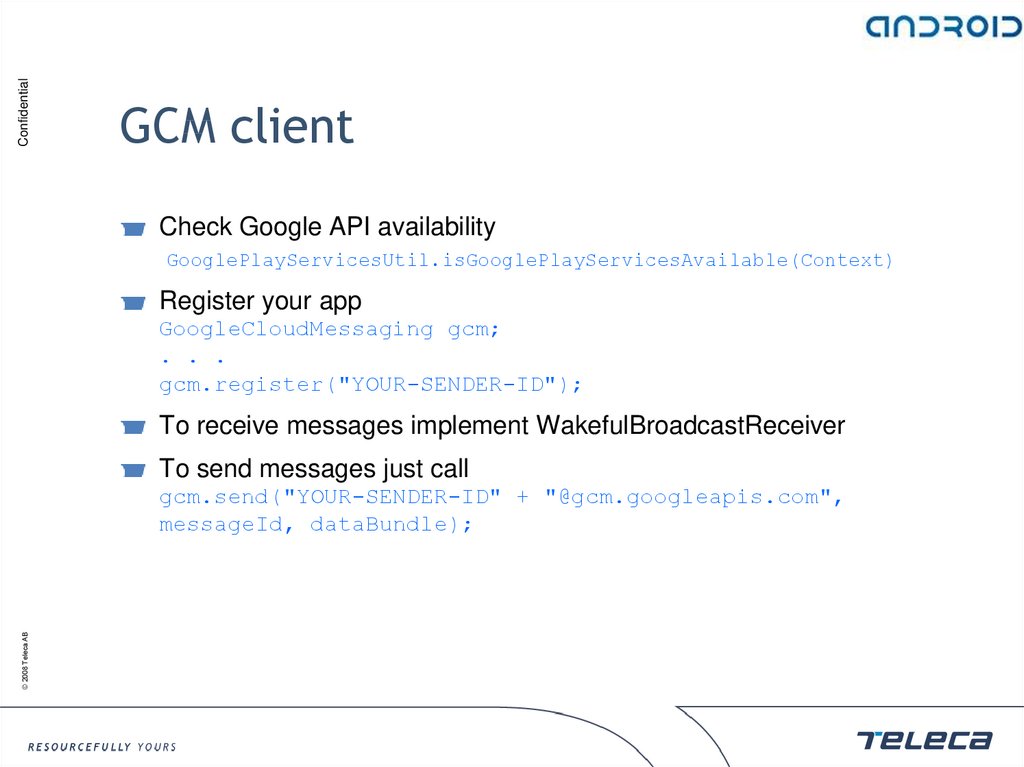
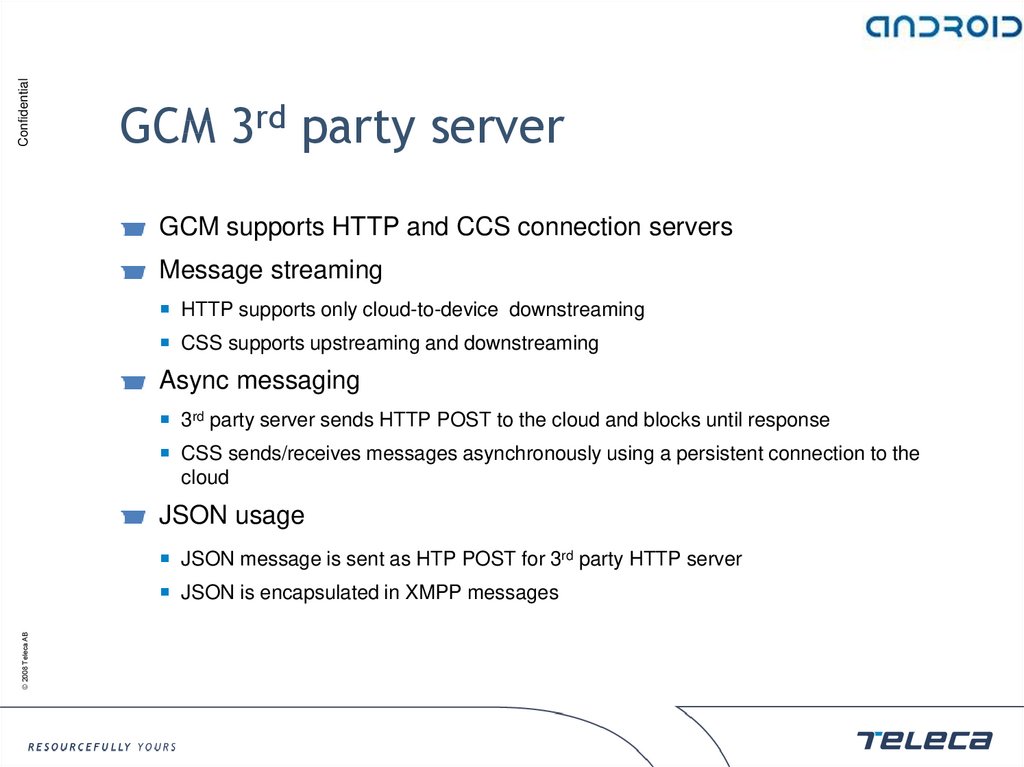
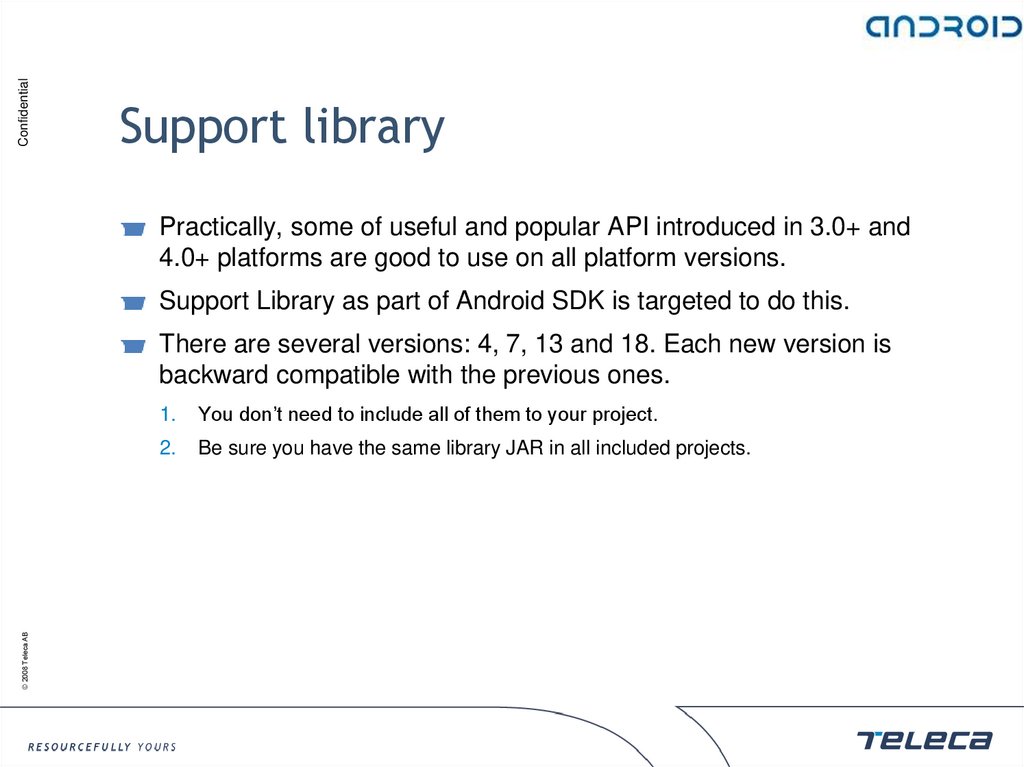
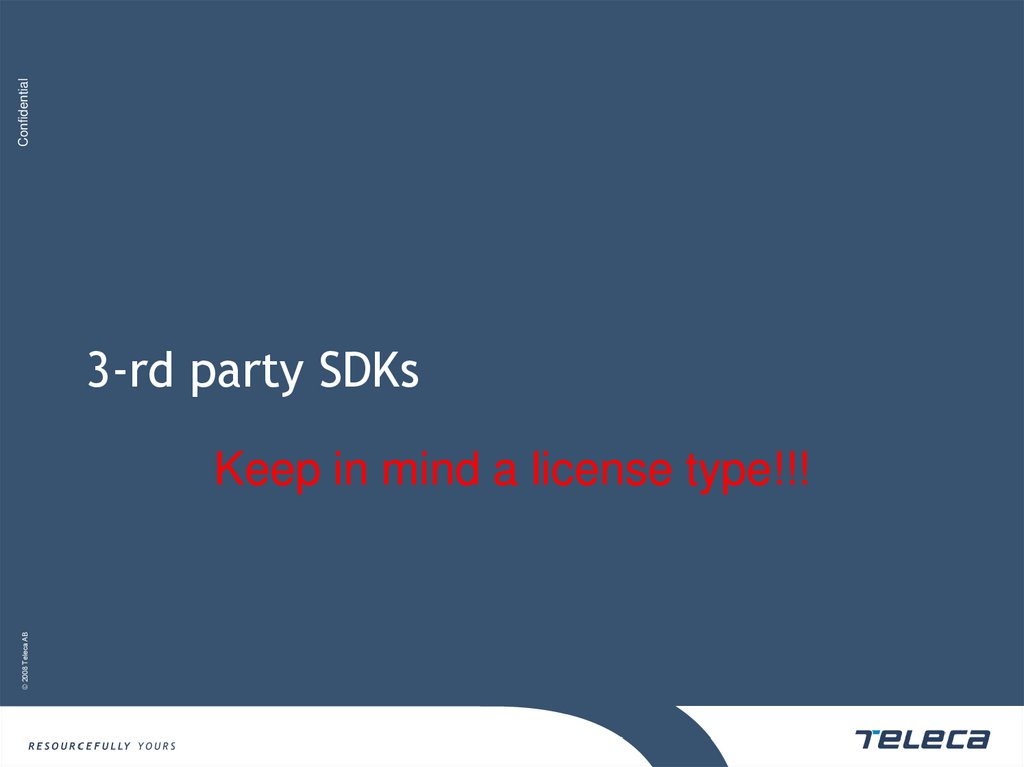
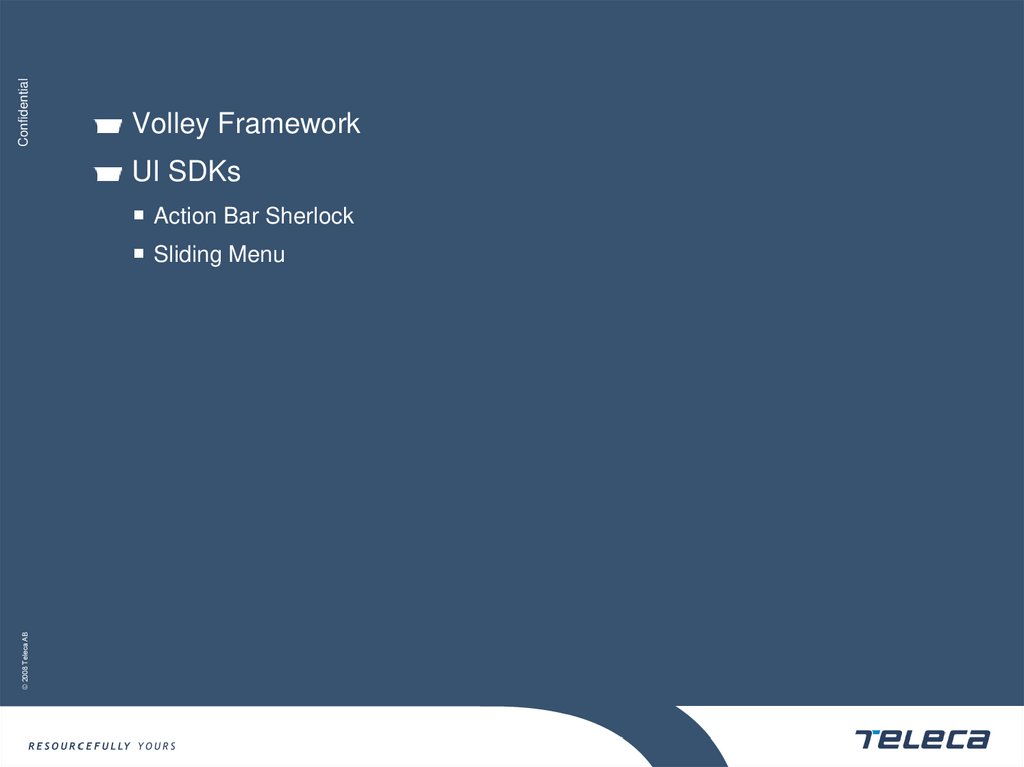
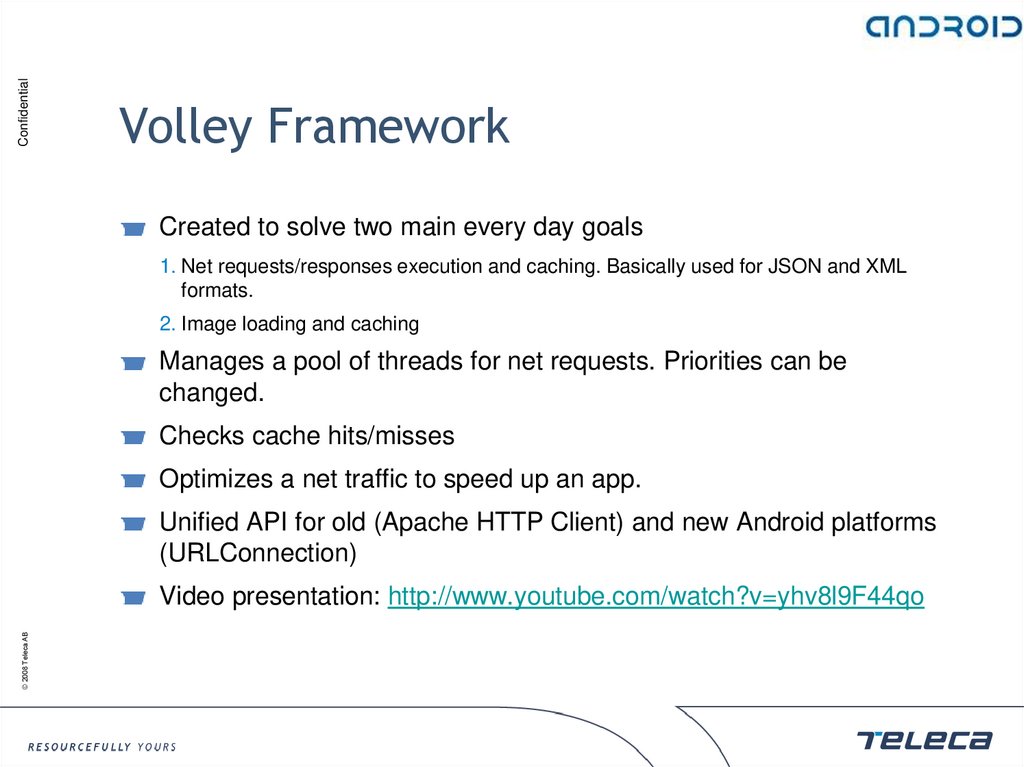

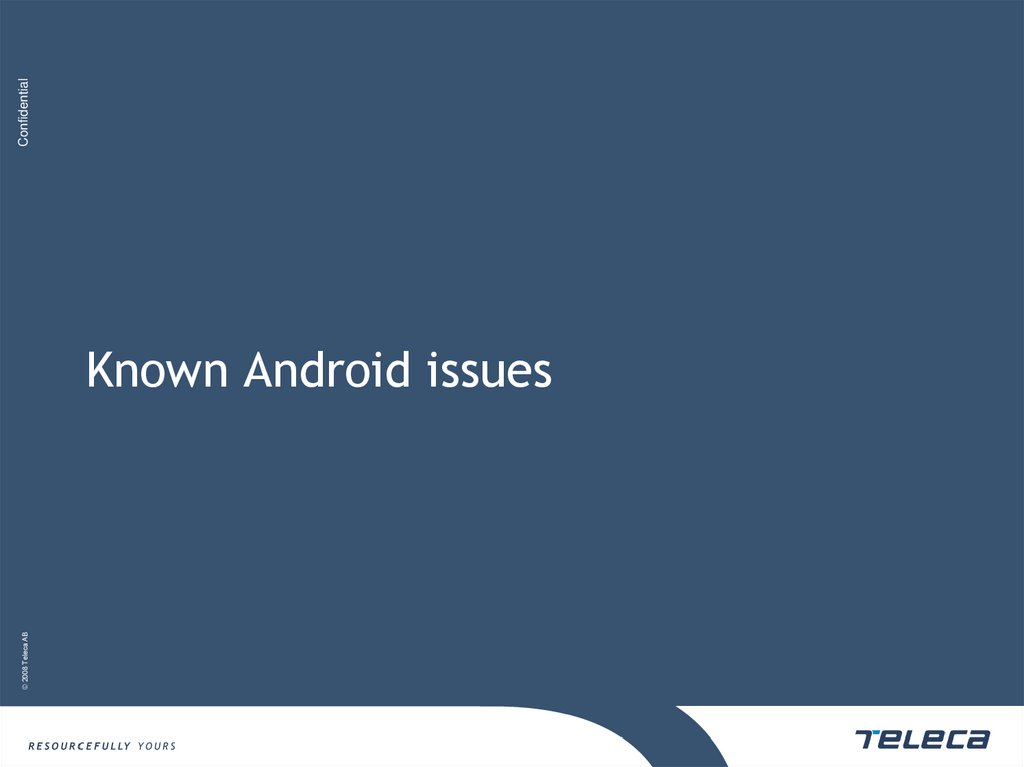


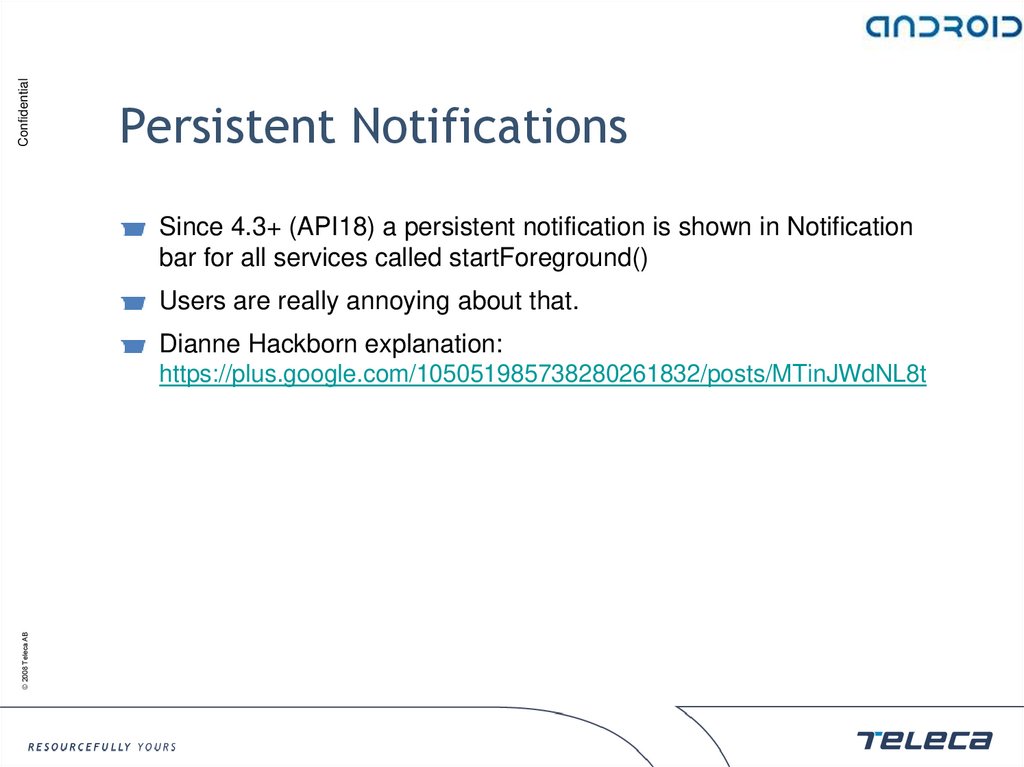

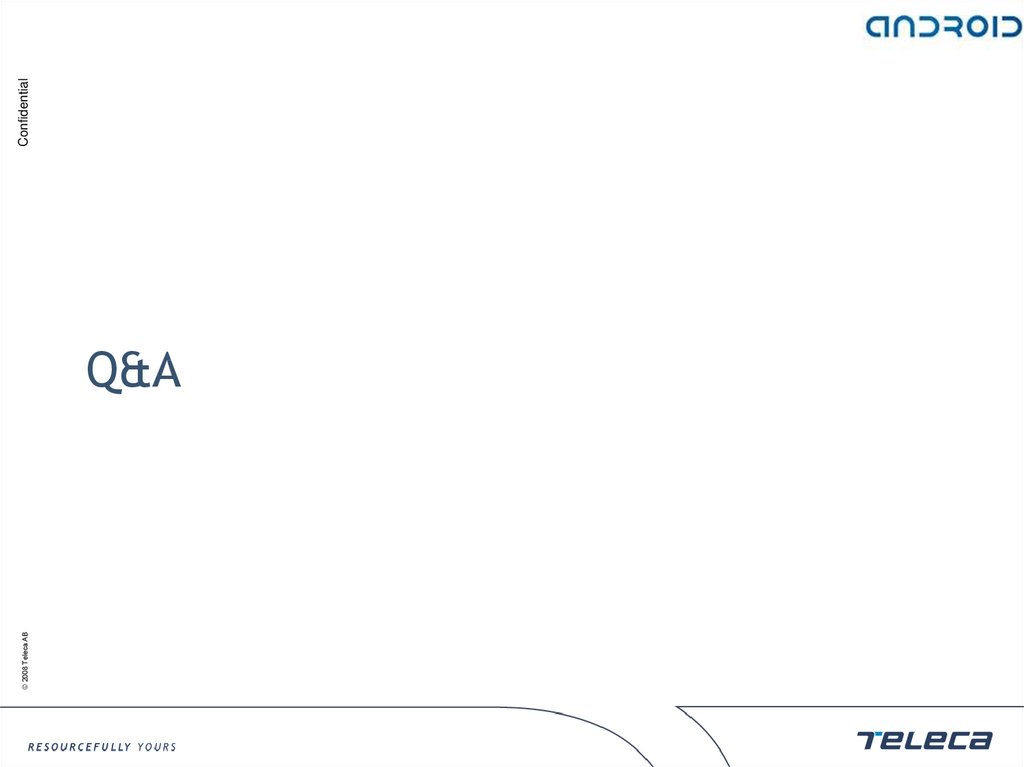
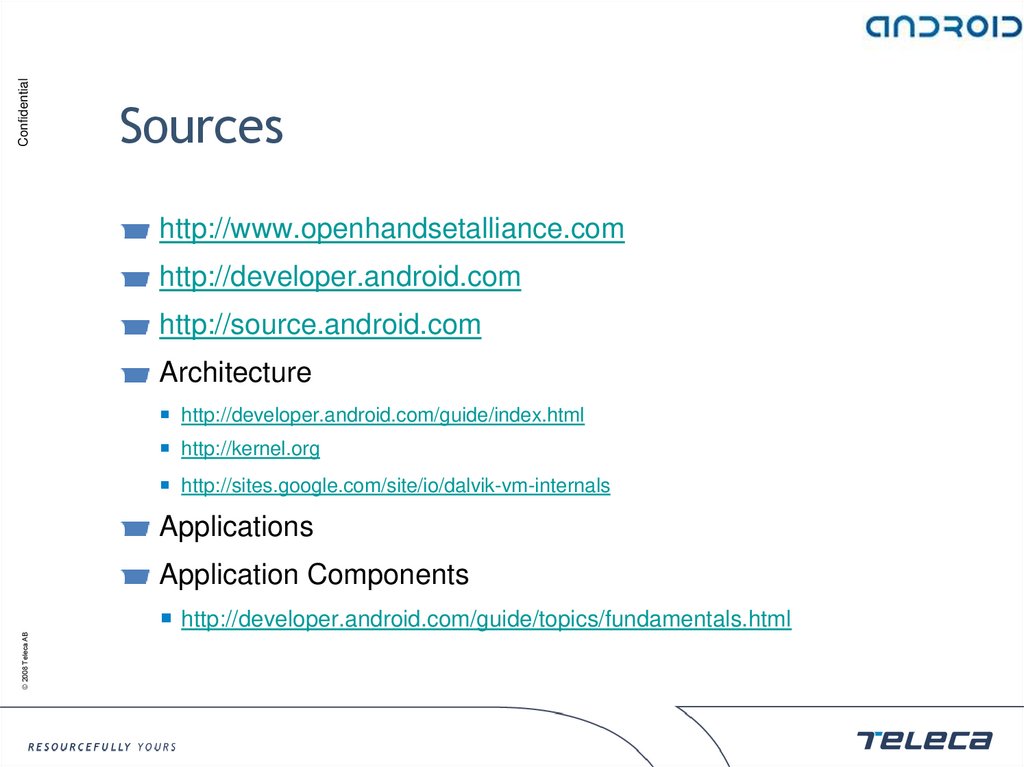
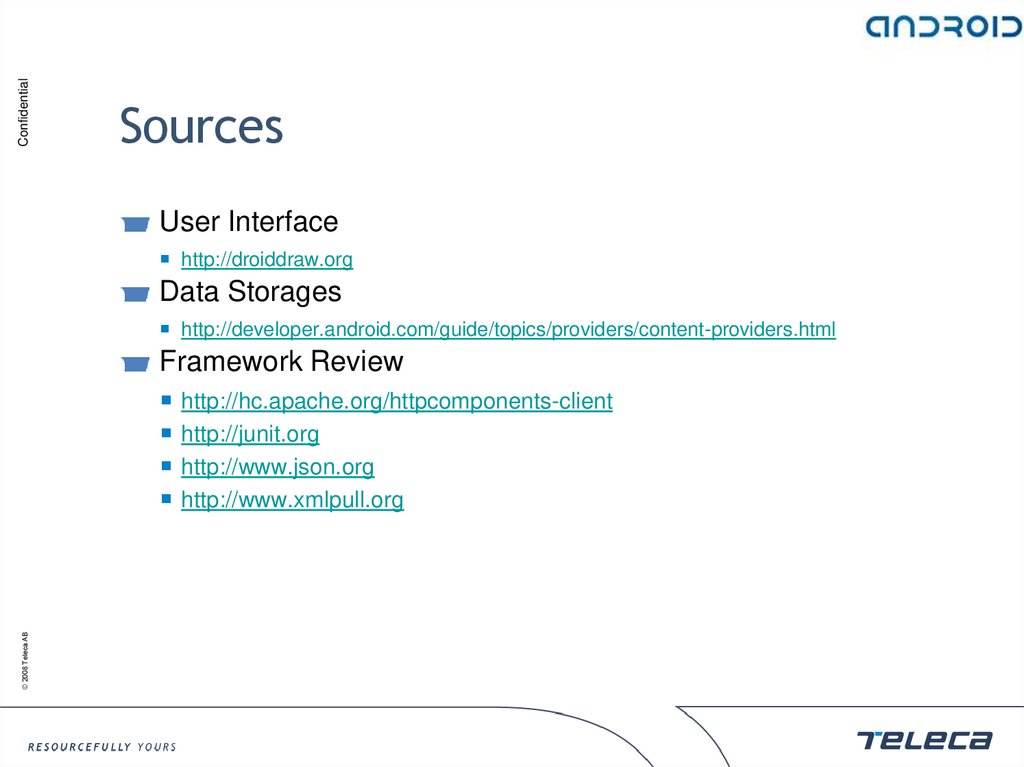
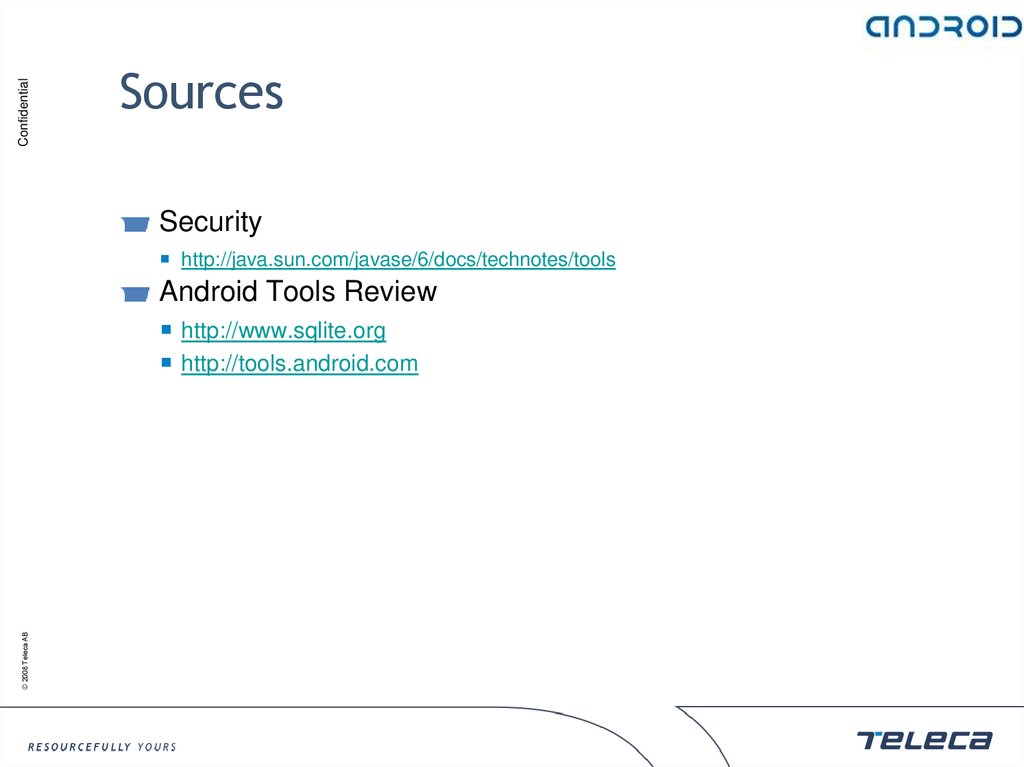
 software
software








